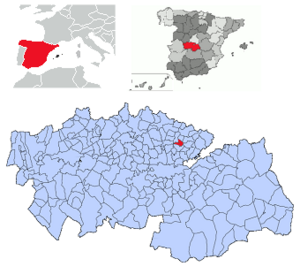Yuncler facts for kids
Quick facts for kids
Yuncler
|
|||
|---|---|---|---|
|
|||
 |
|||
| Country | |||
| Autonomous community | |||
| Province | Toledo | ||
| Comarca | La Sagra | ||
| Judicial district | Illescas | ||
| Founded | See text | ||
| Area | |||
| • Total | 18 km2 (7 sq mi) | ||
| Elevation | 534 m (1,752 ft) | ||
| Population | |||
| • Total | 3,940 | ||
| • Density | 219/km2 (567/sq mi) | ||
| Demonym(s) | Yunclereño,a o Yuncleroso, sa | ||
| Time zone | UTC+1 (CET) | ||
| • Summer (DST) | UTC+2 (CEST) | ||
| Postal code |
45529
|
||
| Official language(s) | Castillian | ||
Yuncler is a small town and a municipality (a type of local government area) in Spain. It's located in the Sagra region, within the province of Toledo. Yuncler is about 42 kilometers (26 miles) south of Madrid, the capital city of Spain.
It shares borders with several other towns. To the south, you'll find Villaluenga de la Sagra. Yuncos and Cedillo are to the north, while Numancia is to the northeast. Pantoja is to the east, and Cedillo is also to the west.
The town's economy used to be mostly based on farming. However, in recent years, many small businesses have started up, bringing new life to the area.
The climate in Yuncler is Mediterranean. This means winters can be cold, with temperatures sometimes dropping below 3°C (37°F). Summers, however, can be very hot, often reaching over 37°C (99°F). While Yuncler doesn't get a lot of rain, it sometimes experiences strong rainstorms.
Contents
What Does Yuncler Mean?
The name Yuncler comes from an old Moorish word. This word was taken from junko, which is the name for a type of plant called sedge (specifically, Cyperus rotundus). In old documents from the 1100s, the town was called Ocner, Yunquer, and Yunkler.
How Yuncler Is Governed
After the elections in 2020, the local government of Yuncler was formed. It includes 9 council members from the PSOE and 2 members from the PP. These are two of the main political parties in Spain.
The current mayor of Yuncler is Luis Miguel Martín Ruíz. He is a member of the PSOE party. The mayor is the head of the local government and helps make decisions for the town.
A Look at Yuncler's History
The first people to settle in Yuncler were of Moorish origin. The town is mentioned in historical documents that date all the way back to the year 1179. This shows that Yuncler has a very long and interesting past.
Interesting Places to Visit
Yuncler has a few special places that are worth seeing:
- Labour House: This building is from the 1800s. It has been kept in its original state and is now a hotel and restaurant called La Casa Grande (The Big House). It's considered a historic place.
- Santa María Magdalena Church: This church is also a historic building. It stands together with La Casa Grande and the modern town hall. All three buildings are located around the main church square, known as Plazuela de la Iglesia.
See also
 In Spanish: Yuncler para niños
In Spanish: Yuncler para niños




